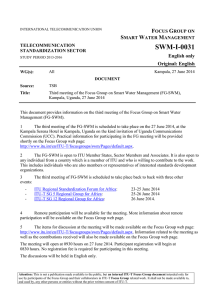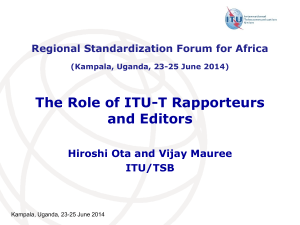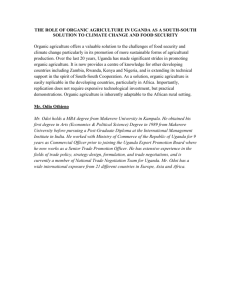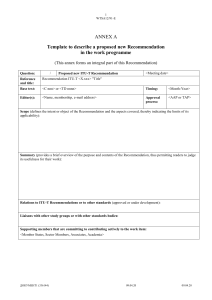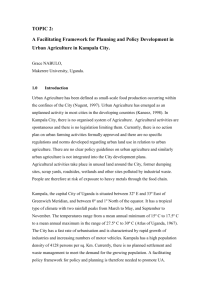Decision-Making and Approval Procedures: soft and hard decisions
advertisement
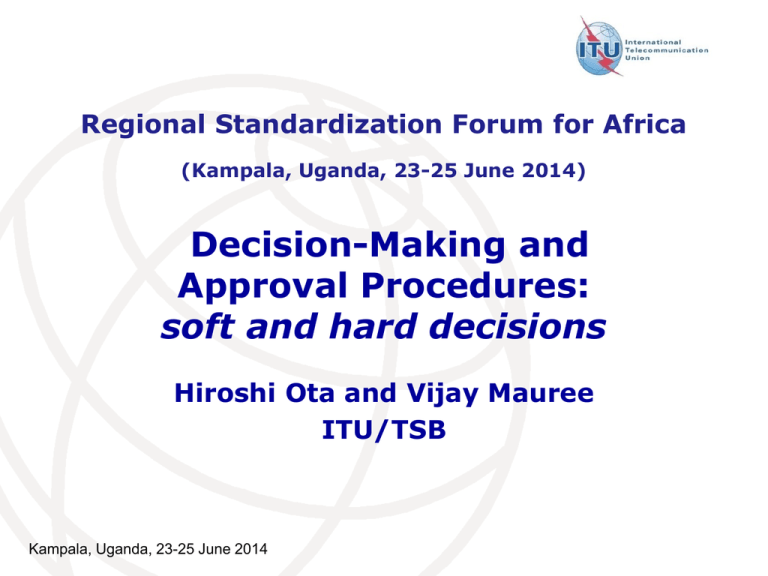
Regional Standardization Forum for Africa (Kampala, Uganda, 23-25 June 2014) Decision-Making and Approval Procedures: soft and hard decisions Hiroshi Ota and Vijay Mauree ITU/TSB Kampala, Uganda, 23-25 June 2014 Outline Types of ITU-T decision-making “soft” and “hard” criteria Traditional Approval Process WTSA Resolution 1, Section 9 Alternative Approval Process Recommendation ITU-T A.8 Kampala, Uganda, 23-25 June 2014 2 Decision Making There are many kinds of decisions made within ITU-T The rules of procedure sometimes indicate quantitative approval criteria but not always The following slides list various ITU-T decision-making mechanisms In general, decision-making avoids formal “voting” in ITU-T First instance I’ve seen in >25 years recently occurred in SG15 Kampal a, Uganda, 23-25 June 2014 3 Decision Making Important note: ITU is a United Nations Specialized Agency – ONLY Member States have the right to vote However, agreement of Sector Members is important for approval of technical Recommendations The rules allow for a public/private partnership, while respecting MS rights Most decisions, but not all of them, are made on the basis of consensus Kampala, Uganda, 23-25 June 2014 4 Decision-Making in ITU-T Decisions to enable progression of work “Soft” criteria SG agrees to start new work SG decides to establish a Focus Group SG determines that a draft Recommendation is sufficiently mature… SG reaches consent that a draft technical Recommendation is sufficiently mature … SG selects the relevant approval procedure by consensus TSAG endorses Questions proposed by SG Kampala, Uganda, 23-25 June 2014 5 Decision-Making in ITU-T Definitive decisions for approvals Quantifiable (“hard”) criteria 70% affirmative of the MSs responding to Formal Consultation to authorize a study group to approve a Recommendation Unopposed agreement of MSs present to approve Recommendation under the Traditional Approval Process (TAP) No more than 1 MS present being in opposition to approve Rec under the Alternative Approval Process (AAP) Kampala, Uganda, 23-25 June 2014 6 Approach to decision making From the examples, we see that some decisions are quantifiable and some are not This has been carefully, and successfully, designed in this manner to have flexibility so work can progress (decides, agrees, determines, etc), but to have specificity when final decisions are taken (unopposed agreement, no more than one MS, etc) Kampala, Uganda, 23-25 June 2014 7 Observations (1) In general, the day-to-day work progresses by consensus among the participants Chairman’s job is to create an environment that allows the meeting to find consensus Resolution of disagreements is generally achieved by those directly involved, with reporting back to parent group Consensus is the foundation of global standardization Kampala, Uganda, 23-25 June 2014 8 Observations (2) Avoid putting a sovereign Member State in a position that forces it to state support or opposition until it is ready to do so, e.g., open voting, show of hands, direct query Elegant solution is “unopposed agreement” Chair can help by carefully crafted questions to move the meeting ahead “Is there any support/opposition to the proposal?” Kampala, Uganda, 23-25 June 2014 9 ITU-T Recommendation Approval There are two methods for approving Recommendations between WTSAs Traditional Approval Process (TAP) for Recommendations having policy or regulatory implications Member States (MS) have final decision Alternative Approval Process (AAP) for all other Recommendations MSs and SMs both fully participate Kampala, Uganda, 23-25 June 2014 10 ITU-T Recommendation Approval TAP is described in WTSA Resolution 1, Section 9 Key terminology, unique to TAP, is summarized in Figure 9.1 – TAP sequence of events AAP is described in Recommendation ITU-T A.8 Key terminology, unique to AAP, is summarized in Figure 1 – AAP sequence of events Kampala, Uganda, 23-25 June 2014 11 Outline Types of ITU-T decision-making “soft” and “hard” criteria Traditional Approval Process WTSA Resolution 1, Section 9 Alternative Approval Process Recommendation ITU-T A.8 Kampala, Uganda, 23-25 June 2014 12 TAP Process Chart Kampala, Uganda, 23-25 June 2014 13 Main steps in TAP (1) SG DETERMINATION (that work is sufficiently mature) Can be done by SG or WP Director’s ANNOUNCEMENT (of intent to seek approval at next SG meeting) Director’s REQUEST (for MSs to approve request that SG can decide on approval; 70% affirmative required) Kampala, Uganda, 23-25 June 2014 14 Main steps in TAP (2) TEXT DISTRIBUTED (at least 1 month before SG meeting) DECISION meeting Approval requires unopposed agreement of the MSs present Kampala, Uganda, 23-25 June 2014 15 Other steps in the process (1) SMs, MSs, Associates, Academia participants and liaisons can propose changes for the DECISION meeting’s consideration of the DETERMINED text Editorial corrections and amendments not affecting the substance may be accepted A Recommendation Summary is required Kampala, Uganda, 23-25 June 2014 16 Other steps in the process (2) If there are major changes, the SG should defer approval to another meeting, EXCEPT The SG can proceed with approval if the Study Group Chairman, in consultation with TSB, considers that changes are reasonable for MSs not present and that the proposed text is stable This is a very, very normal occurrence Kampala, Uganda, 23-25 June 2014 17 Other steps in the process (3) A MS that does not want to oppose approval but has a concern, can have its concern noted in meeting report and in the Recommendation If a MS requests more time to consider its position, the “4-week rule” allows that MS to inform TSB of its disapproval within 4 weeks of the meeting No reply from that MS means no objection, and the Recommendation is approved Kampala, Uganda, 23-25 June 2014 18 Outline Types of ITU-T decision-making “soft” and “hard” criteria Traditional Approval Process WTSA Resolution 1, Section 9 Alternative Approval Process Recommendation ITU-T A.8 Kampala, Uganda, 23-25 June 2014 19 Evolution of the approval process for dramatic improvement 2001: After adoption by a SG, Recs that do not require formal consultation of the MSs are considered as approved Only applies to Recs that do not have policy or regulatory implications, or for which there is a doubt This is known as the Alternative Approval Process (AAP) Kampala, Uganda, 23-25 June 2014 20 AAP Process Chart Approved LC 4 weeks SG or WP meeting (1) LC: AR: Edited Director's text announcement for LC and posting (2) for LC (3) Last Call Additional Review (a) 4 3 weeks (b) (c) Comment resolution (7) (a) 9 AR 3 weeks (b) Edited Director's text announcement for AR and posting (8) for AR (10) Approved Director's SG announcement Meeting and posting (6) ( 5 ) (b) Approved 11 (a) Director's notification and publication (see ITU-T. A.11) (12) A.8(08)_F01 Kampala, Uganda, 23-25 June 2014 21 Main steps in AAP (1) CONSENT (that work is sufficiently mature) Can be done by SG or WP Same as DETERMINATION in TAP Director’s AAP ANNOUNCEMENT of LAST CALL (review before approval) Posted on the 1st and 16th of every month LAST CALL (LC) is 4 weeks MSs, SMs, Associates and Academia participants can submit LC comments Kampala, Uganda, 23-25 June 2014 22 Main steps in AAP (2) If there are no comments (other than typographical corrections) the Rec is approved If there are any comments, including “editorial” comments, SG Chairman considers next step in Last Call Judgment Consult with relevant experts and TSB Address and attempt to resolve comments Provide new, revised text and report on comment resolution attempts Kampala, Uganda, 23-25 June 2014 23 Main steps in AAP (3) Depending on calendar, Chairman has a choice to get the fastest approval: (1) Post revised text for an Additional Review (AR) of 3-weeks, MSs and SMs can comment This is the most common course If there are no comments in 3 weeks, the Recommendation is approved; or (2) Send draft revised Recommendation and comments to next SG meeting Kampala, Uganda, 23-25 June 2014 24 Main steps in AAP (4) If there are AR comments, Chairman considers next steps in Additional Review Judgment Changes are only typographical; Recommendation is approved Comments are substantive or “editorial”; draft Recommendation and all comments are sent to the next SG meeting Kampala, Uganda, 23-25 June 2014 25 Main steps in AAP (5) At SG meeting, if there are major changes, the SG should defer approval to another meeting, EXCEPT The SG can proceed with approval if the SG Chairman, in consultation with TSB, considers that changes are reasonable for MSs not present and that the proposed text is stable This is a very, very normal occurrence Only about 2% of AAP Recommendations even get to the SG stage Kampala, Uganda, 23-25 June 2014 26 Main steps in AAP (6) Draft Recommendation may have gone through many changes at the SG, causing a new MS concern: If a MS states that the Rec now has policy or regulatory implications, the Rec can be moved back to the beginning of TAP or AAP SG does not make a DECISION at this meeting SG picks path that will ensure best progress towards a decision Kampala, Uganda, 23-25 June 2014 27 Main steps in AAP (7) If there is unopposed agreement of MSs and SMs present, Recommendation is approved If there continues to be any objection, the Chair asks only MSs present if there is objection to approval Recommendation is not approved if there is more than one MS objecting (i.e., 2 or more MSs) Recommendation is approved if 1 or no MSs object Kampala, Uganda, 23-25 June 2014 28 AAP Experience About 65% of AAP Recommendations are approved in LAST CALL with no comments More than 85% of AAP Recommendations are approved in LAST CALL About 2% of AAP Recommendations need to go to the SG DECISION meeting Average time from CONSENT to NOTIFICATION of approval is 9 weeks Efficient management of the AAP process is a key task for SG Chairmen, Rapporteurs and Editors Kampala, Uganda, 23-25 June 2014 29 Amendments and Corrigenda Amendment to a published Rec: Includes only the change or addition If integral (normative) part of Recommendation: Approved using the same approval process as the Rec If not integral (informative): agreed by SG Corrigendum to published Recommendation: Includes only the correction Obvious correction: published by TSB with concurrence of SG Chairman Otherwise: same approval as for Rec Kampala, Uganda, 23-25 June 2014 30 Implementer’s Guide and Revisions Implementer’s Guide: Historical record of identified defects with their corrections since Rec was published Agreed by SG, or by WP with concurrence of SG Chairman Eventually issued as Corrigenda (Corr.) or Revised (Rev.) Revision: Full text of published Rec with all approved changes, corrections, additions Same approval process as for Rec Kampala, Uganda, 23-25 June 2014 31 Deletion of Recommendation Deletion is considered on a case by case basis Recommendation has been superseded or has become obsolete Choices: Deletion by WTSA or between WTSAs Deletion by WTSA: Upon decision of SG, Chair reports to WTSA requesting deletion WTSA acts as appropriate Kampala, Uganda, 23-25 June 2014 32 Deletion of Recommendation - TAP SG agrees to deletion by unopposed agreement Inform membership of proposed deletion, including an explanatory summary of the reasons, via Circular If no objection within 3 months, deletion comes into force In case of objection, refer back to the SG Kampala, Uganda, 23-25 June 2014 33 Deletion of Recommendation - AAP SG agrees to deletion by unopposed agreement of MSs and SMs present If not achieved, then SG agrees to deletion if no more than 1 MS present is opposed Inform membership of proposed deletion, including explanatory summary of the reasons, via Circular If no objection from a MS or SM within 3 months, deletion comes into force In case of objection, refer back to SG Kampala, Uganda, 23-25 June 2014 34 Additional Information Doc. Link Basic Texts (ITU Constitution, Convention and General Rules of Conferences, Assemblies and Meetings of the Union; Resolutions and Decisions of 2010 Plenipot http://www.itu.int/S-CONF-PLEN-2011ZIP-E.zip General Rules of Conferences, Assemblies and Meetings of the Union http://www.itu.int/net/about/basictexts/rules.aspx WTSA Resolution 1 http://www.itu.int/pub/T-RES-T.1-2012/en Recommendation ITU-T A.1 http://www.itu.int/ITUT/recommendations/rec.aspx?rec=11920 Kampala, Uganda, 23-25 June 2014 35
